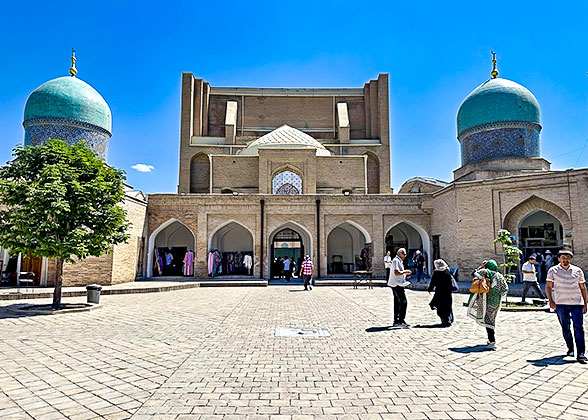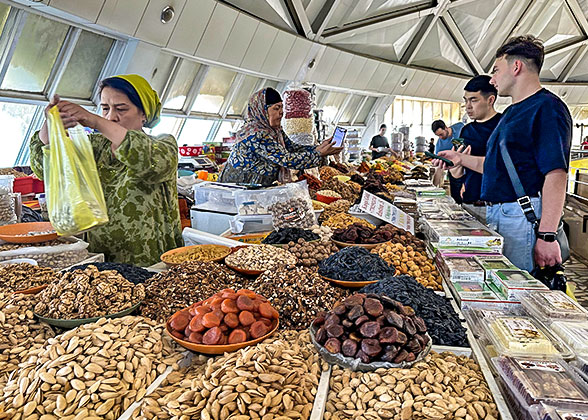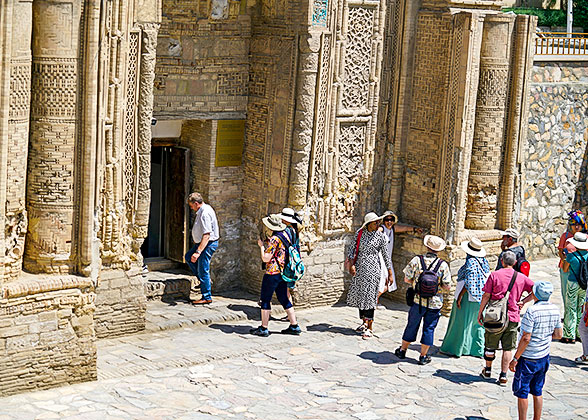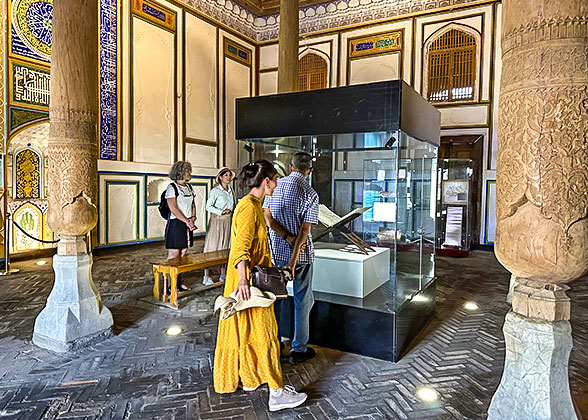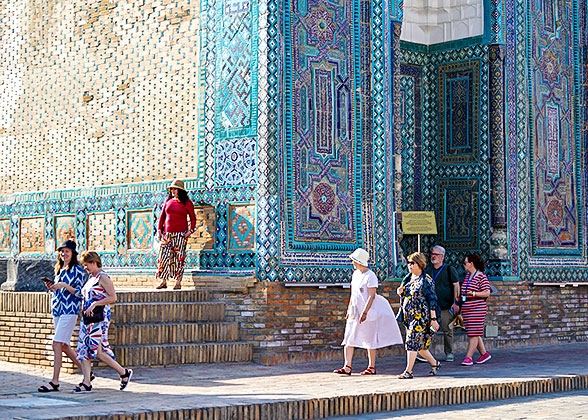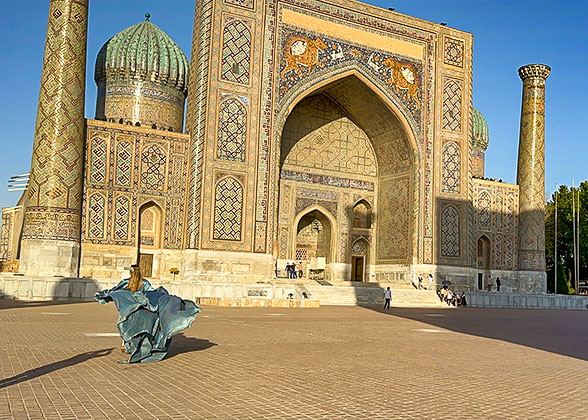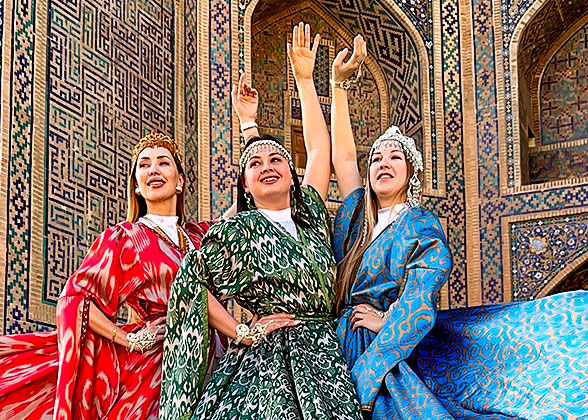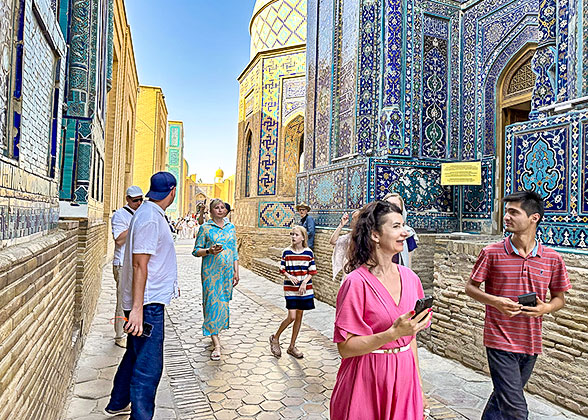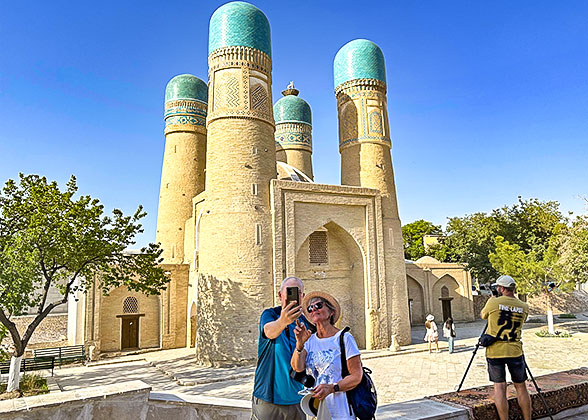Day 1: Airport Pick-up & Tashkent Tour: Khast-Imam Complex, Chorsu Bazaar, Museum of Applied Art
Thanks for choosing our Tashkent tour package, and welcome to your first destination of Uzbekistan! Strategically positioned on the Silk Road between Europe and China, Tashkent was a military stronghold that was successively conquered by the Persians, Arabs, Mongols, and Tsarist Russia. So, you can feel the cultural collision by exploring Russian-style and Central Asian Islamic architecture. Upon arrival, the local driver will pick you up at the airport and then escort you to the hotel. After settling down, your guide and the driver will accompany you to Tashkent’s spiritual center, the Khast-Imam Complex, where the Barakh-khan Madrasah, with a distinctive Persian portal, and the Tilla Sheikh Mosque, built in a perfectly symmetrical structure, represents the most classic Islamic architecture. Adjacent to the mosque, a turquoise dome marks the Abubakr Kaffal-Shashi Mausoleum. The Islamic Institute of Imam al-Bukhari, one of the paramount Islamic scholarship centers in Central Asia, completes the plaza. Then, head to the Chorsu Bazaar, where you can experience daily life by tasting local street food and exploring various handicrafts, such as pottery and tapestries. After browsing the bustling stalls, we’ll drive to the State Museum of Applied Art, which houses over 7,000 artifacts from the 19th century onward, such as ceramics, jewelry, and ethnic costumes from all over Uzbekistan. Among them, Suzani embroidery is a must-see. Crafted on cotton or silk fabric, Suzani is decorated with cotton or silk-embroidered patterns such as the sun, moon, flowers, and vines. In Uzbekistan, it is often used as a dowry to ward off the evil eye and bless the newlyweds. Afterwards, the guide will especially accompany you to try the Tashkent subway, whose 29 stations are designed with different themes. The Kosmonavtlar station is one of the most popular photo spots, featuring a blue-toned space exploration whose white ceiling is inspired by the Milky Way, and the walls are decorated with ceramic medallions of Soviet pioneering cosmonauts. Let’s get off at Independence Square and stroll to the Amir Timur Park to pay homage to the statue of Timur, who built an empire spanning from Russia and India to the Mediterranean Sea from 1370 to 1507. The Tashkent tour will end at the Earthquake Memorial, a monument to the victims of the 1966 earthquake.  Insider Suggestions: 1. Visa Requirement: Visitors from 66 countries, including the UK, Canada, Malaysia, and the EU, enjoy a visa exemption policy. The 55 countries, including the US, are on the list of e-visa requirements. It's good to know that Americans under 16 and over 55 years old can enter Uzbekistan visa-free. 2. Currency & Payment: Since e-pay and credit cards are not widely used in Uzbekistan, cash is king. It is convenient to exchange Uzbekistani som (UZS) at ATMs, but please note that only Visa, Maestro cards, and US dollar cash are accepted. Generally, USD 200-300 is enough for 6 days. Accommodation: Wyndham Tashkent (4 stars) or similar
|
Day 2: High-speed Train to Bukhara, Visit Chor-Minor Madrasah, Trade Domes Market & Kalyan Minaret
Today, the driver will send you to the train station for a 4-hour rail journey to Bukhara. With a 2,500-year-old history, it is one of the oldest cities in Central Asia, listed as a UNESCO World Heritage Site. Upon arrival, the local driver will escort you to the hotel to store your luggage before the Bukhara walking tour. Lyabi Hauz Ensemble, the heart of the old city, will be our starting point. By its central water pool stand two Islamic institutions and a Sufi sanctuary encompassing a mosque and a jail, surrounded by restaurants, cafes, and souvenir shops. To the west, we’ll reach Bukhara’s oldest structure, Magoki-Attori Mosque, constructed in the 9th century, with a less dazzling façade due to the lack of colorful tiles. However, its peeled blue-glazed portal and intricately carved floral patterns are both testaments to its history. A 10-minute walk eastward from the mosque, the delicate Chor-Minor Madrasah stands elegantly with four blue domes shimmering under the sun. Take your time to snap the same photo as the cover of the Lonely Planet Central Asia. The trip continues to the Trade Domes Market, whose large central dome is surrounded by many smaller ones, looking like a bubbling pizza crust from afar. There are four domed bazaars in Bukhara, which historically specialized in currency exchange, hat sales, jewelry, and silk, and currently are ideal to hunt for traditional Uzbek handicrafts like ceramics, silk, and handmade carpets in any of them. After visiting two ancient Islamic schools, Ulugh Beg Madrassah and Abdulaziz Khan Madrassah, you’ll be intrigued by the Kalyan Minaret. Completed in 1127, it has dominated the city's skyline for centuries, once serving as a beacon for caravans. Legend has it that when Genghis Khan conquered Bukhara in the 12th century, he ordered the devastation of most buildings here, leaving only the 47-meter (154-foot) high tower. Standing at its foot, you can see 14 distinct bands of blue mosaic patterns decorated on its honey-colored body. Unfortunately, the adjacent Kalyan Mosque was not spared by the Khan. The current structure, featuring a striking turquoise dome, is a 16th-century reconstruction of the original site. Measuring 127 meters (416 feet) long by 78 meters (256 feet) wide, it can accommodate up to 12,000 worshippers and is still in use today. Following Miri-Arab Madrasah, we’ll ascend the rampart of the Ark Fortress, built in the 5th century, to admire the panoramic view of the entire city. If you happen to catch the sunset, it would be a great chance to capture the golden skyline of Bukhara. After admiring the exquisitely carved pillars at Bolo Hauz Mosque and complex brickworks at Samanid Mausoleum, the Bukhara city tour will end at Chashma Ayub Mausoleum, now a water museum showing Bukhara’s ancient water system. Finally, we’ll return to the hotel.  Recommended Restaurant: (at your own expense) The Plov Restaurant specializes in Uzbekistan’s national dish, plov (also called pilaf), offering both Samarkand and Bukhara styles. The Bukhara style includes raisins to add sweetness, but it is otherwise quite similar. The rice is first steamed with stir-fried beef or lamb, carrots, chickpeas, and garlic, then constantly stirred with olive oil and cumin until every grain is covered with juice. The plov may be greasy, so you can order a cup of Gulob tea - a sweet, chilled jasmine tea - to cleanse the palate. Average Cost Per Person: USD 4. MasterCard and Visa cards are acceptable. Address: 200100, Bukhara region, Bukhara, Street Ibn Sino, 8/1 Meals: Breakfast Accommodation: Volida Hotel Bukhara (3 stars) or similar
|
Day 3: Bukhara: Summer Palace, Naqshbandi Memorial Complex, Chor-Bakr Necropolis; Train to Samarkand
Today, the driver and the guide will pick you up at the hotel, and then let’s head to the Summer Palace (Sitorai Mohi Hosa), a fusion of European and Central Asian styles, whose colorful gateway will catch your eye at once. Stepping into a European-style building beside the pond, you’ll be astonished by the lavish Central Asian motifs and wooden carvings on the walls. In its reception hall, exquisite artifacts, including intricate carpets, jewels, and Chinese and Japanese porcelain vases, are displayed. Then, continue to the Memorial Complex of Bahouddin Naqshband, a religious shrine of the Sufi Order "Naqshbandia" that consists of tombs of the founder of the sect, an Islamic school, a Sufi lodge, and a mosque. Finally, head to the Chor-Bakr Necropolis, the graves of four Islamic saints from the Bakr family in the 16th century. It is believed that if you pray at all four saints’ tombs in one day, your wishes will come true.  Bukhara: Once the Homeland of the Lost Sogdian Civilization Located in the heart of Eurasia, Bukhara was once a trade hub connecting Persia, India, and China. The Sogdians, a merchant ethnic group along the Silk Road, settled here and organized caravans transporting silk, spices, and jewelry 2,500 years ago. Without establishing their own country, they had to seek protection from other regimes. During the 6th to 7th centuries, they established marital alliances with Turkic nobles, which propelled Bukhara to prosperity. However, as a side effect, Sogdian culture gradually merged with Turko-Islamic traditions and vanished from the land. Their architecture was eventually replaced by the Islamic structures you have visited in the city. In the afternoon, the guide and the driver will escort you to the railway station for the high-speed train to Samarkand. After a 2-hour train ride, our Samarkand driver will pick you up at the train station and transfer you to the hotel. Meals: Breakfast Accommodation: Grand Samarkand Superior (4 stars) or similar
|
Day 4: Samarkand: Registan Square, Bibi Khanym Mosque, Shah-i-Zinda Necropolis, Gur-Emir Mausoleum
Established in 650 BC, Samarkand is even older than Bukhara. It was razed to ash by Genghis Khan in 1220. Thanks to Timur, who established the Timurid Empire (1370-1507) and made Samarkand his capital in the 14th century, we can see a city filled with numerous grandiose Islamic buildings. After breakfast, you’ll be accompanied to the spiritual center of Samarkand - Registan Square, where the city’s three most ancient Islamic schools stand, offering an overview of the Timurid architecture. Then, step into the Siyob Bazaar and wander through rows of booths, hearing the chanting of hawkers and smelling the mixed aroma of fruits and spices. Near the bazaar, the Bibi Khanym Mosque, one of Samarkand's landmarks, comes into view. Its construction was initiated in 1399 and finished in 5 years, fusing Persian, Central Asian, and Arabian architectural elements. With a 38-meter-high (125-foot) entrance portal and a grand dome rising to 41 meters (135 feet) at its vertices, it ranks among the grandest Islamic mosques. Reportedly, the portal was decorated with patterns that replicate the Milky Way, but it collapsed shortly after completion. Wandering in the courtyard, you can see a marble stand, on which a huge ancient Quran is showcased. It was believed that women who wanted a child and crawled beneath the base would have their dreams come true. Although the marble is now covered by glass, making a wish to the Quran may still be fulfilled. Next, we’ll visit the heritage of the largest observatory in Central Asia - Ulugbek Observatory, built by Ulugbek, Timur's grandson, which marked the last peak of Central Asian technology. After visiting Shah-i-Zinda Necropolis, the resting place of Timurid princesses, continue to Gur-Emir Mausoleum, where Timur and other members of the royal family are buried. Gazing upward, you’ll see its deep-blue domes trimmed in gold, adorned with white floral patterns that evoke a starry sky. There was a legend that a curse was incised on Timur’s tombstone saying that “the one who opens my tomb will be defended by an enemy stronger than me.” Maybe by coincidence, after three days Soviet archaeologists opened his tomb in 1941, Nazis broke the Molotov-Ribbentrop Pact and invaded their home country.  Destroyer of Samarkand - Genghis Khan By the early 13th century, Genghis Khan dispatched a group of merchant caravans laden with gold, furs, and silver to seek trade with the Khwarezm Empire, a Turco-Persian State during the 11th-13th centuries. However, all the merchants were framed as spies and massacred, with goods being confiscated. The Khan was enraged and launched a westward campaign. In 1220, his cavalry besieged Samarkand, slaughtering defenders and local civilians, and plundering treasures. According to the book, History of the World Conqueror, before Genghis Khan’s arrival, Samarkand was a paradise on earth where pearls were used as stones and musk as soil. Khan swept over and left the once-prosperous city in ruins. Meals: Breakfast Accommodation: Grand Samarkand Superior (4 stars) or similar
|
Day 5: Samarkand: Afrasiab Museum, Tomb of Saint Daniel, Koni Ghil Village; Train to Tashkent
After breakfast, we’ll head to the Afrasiab Museum. Perched on the heritage of the ancient capital of Sogdia, a pivotal Silk Road kingdom, the museum preserves over 22,000 artifacts excavated from the ruins. The undisputed highlights of the museum are the 7th-century frescoes in the Hall of Ambassadors, which freeze moments of diplomatic scenes among the Silk Road countries, such as Sogdian kings receiving foreign envoys, the empress of the Chinese Tang Dynasty cruising over the lake, and a procession of a king and a princess. Besides, ossuaries and skeletal remains of Uzbekistani ancestors are on display. Then, we'll go to the Tomb of Saint Daniel, where you can see many locals kneeling to drink its spring water, since it is said to be able to heal diseases. ★ Explore the Traditional Making Process of Samarkand PaperWhen Chinese paper-making technology was introduced via the Silk Road in the 8th century, Samarkand became the first paper-making hub in Central Asia. Though faded during the Industrial Revolution in the 19th century, the Koni Ghil Village established a workshop to revive the ancient mulberry-bark paper craft in the 20th century. In the hamlet, you can witness the whole process of papermaking. The craftsmen first steep the branches in water until they become soft, then strip, boil, sun-dry, and pound them to mash. Put the fibers in water and sieve them through bamboo screens. The paper will be finished after being pressed, dried, and polished smooth with horn or seashell. In addition, you can hang around the village to find the waterwheels set above the stream, rest at the teahouse, or explore the nearby sights on your own. In the afternoon, you’ll be transferred to the train station to take a 2-hour high-speed train back to Tashkent. As soon as you arrive, the local driver will pick you up and escort you to the hotel for check-in.  Where to Kill Time after Arriving in Tashkent If you arrive in Tashkent early in the afternoon, you can head to Besh Qozon (Plov Center) by yourself to dive into Uzbek culinary culture. Besides tasting the most authentic plov, you can also watch the cooking process in its open kitchen, where five 2-3-meter-wide (6-9-foot) pots are installed. It costs about UZS 30,000-60,000 (USD 2-4) per person to dine here. Adjacent to the restaurant, Tashkent TV Tower is also worth a visit. Ascend to its observation deck on the 6th floor at dusk, and you can get a panoramic vista and see the golden skyline of the city. The entrance ticket costs UZS 50,000 (USD 4). Address of the Besh Qozon Restaurant: Guards Colonel Khodjaev Street 1, Tashkent 100057, Uzbekistan ► Car-Hailing Tip: YandexGo is reliable. It allows e-pay with a Visa card. You can also hail a car on the street, but please check the fare before boarding: the flag-down fare is UZS 8,000-10,000 (USD 0.6-0.7) and UZS 2,000-3,000 (USD 0.1-0.2) per km. Meals: Breakfast Accommodation: Wyndham Tashkent (4 stars) or similar
|
Day 6: Departure from Tashkent, Airport See-off
Today, the driver will send you to Tashkent International Airport. We wish you a pleasant voyage.
Beyond Islamic architecture, you can extend the itinerary to see Uzbekistan’s natural beauty, like the Aral Sea and Lake Sudochie. The itinerary can also be tailored to other Silk Road countries, such as Kyrgyzstan, Kazakhstan, Tajikistan, and Turkmenistan. Welcome to your consultation, and we will reply within 12 hours!
Meals: Breakfast
|

